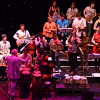Home » Jazz Articles » Live Review » Grand Union Orchestra: London, UK, June 7, 2013
Grand Union Orchestra: London, UK, June 7, 2013
Spirits of Cable Street
Wilton's
London, UK
June 7, 2013
A tribute to music hall star Marie Lloyd set to a reggae beat? Could only be Grand Union Orchestra. Surprisingly, this is only the band's second visit to Wilton's, this historic East End venue that sits very close to the site of the battle of Cable Street. If you caught Stephen Poliakoff's 1930s jazz drama, Dancing on the Edge, on the BBC, then you may know that the theatre appeared in several scenes from the play. Somehow, it's the perfect setting for Grand Union's unique blend of jazz and the music of Asia, Africa, South America and the Caribbean.
This was a scaled down GUO, albeit in numbers only. There was no diminishing of ambition or scale when it came to the music. As ever, the orchestra took its audience on a global journey—tonight taking in both Hindustani and Carnatic traditions from India, Chinese classical music, samba and salsa, ska and reggae all leavened with a healthy dose of the blues.
But is it jazz? From its origins, jazz has been a syncretic music. What GUO leader Tony Haynes does is bring it to new places, new worlds and new sources of inspiration. "Mishra Kafi" began as a South Indian rag with some richly evocative violin from Jyotsna Srikanth—perhaps the star of the show—before morphing into a Brazilian samba and then returning home via the Mississippi. Ever hear a guy play blues sitar? Well, Baluji Shrivastav can play it like he learned at the feet of Robert Johnson.
And there was jazz too, almost straight on "Feelin' Nice" and Afro-Cuban on "Tierra Roja," both with some remarkable tenor from Louise Elliott and fine trumpet and flugelhorn from Shanti Paul Jayasinha. And who else but Grand Union would feature the Trinidadian steel pan of Daniel Louis in a gorgeous classical Chinese tune like "Song of Four Seasons"? This was, in fact, one of the highlights of the evening, with its stunning flute duet from master musician Ruijun Hu and Louise Elliott.
Marie Lloyd's "Follow the Van" was given a reggae lilt:
"Marie Lloyd's gone to the West Indies.'"
"Jamaica?"
"No, she went of her own accord."
It worked. And then, the orchestra closed with the wonderful "Rag Hamsadhvani." No matter how many times I hear the gymnastics of Indian Konnakol singing, it never ceases to lift the soul. Here it drew upon the vocal talents of Paul Jayasinha, Baluji Shrivastav, Jyotsna Srikanth and the orchestra's tabla player, Yousuf Ali Khan, bringing an end to what was the strongest, most liberating performance yet heard from this incredible band.
Spirits of Cable Street is a manifesto recalling instantly the vibrant history of an area of London through which generations of immigrants have passed. It is also a reminder of the Jews, socialists and trades unionists who stopped Oswald Mosley's black-shirted thugs in the thirties when they tried to march through the East End. It tells of a working class culture of resistance, and now—in the hands of the Grand Union Orchestra—it speaks boldly of new ways of making jazz.
< Previous
No. 9
Next >
In Full View
Comments
Tags
Grand Union Orchestra
Live Reviews
Duncan Heining
United Kingdom
London
robert johnson
Paul Jayasinha
For the Love of Jazz
 All About Jazz has been a pillar of jazz since 1995, championing it as an art form and, more importantly, supporting the musicians who create it. Our enduring commitment has made "AAJ" one of the most culturally important websites of its kind, read by hundreds of thousands of fans, musicians and industry figures every month.
All About Jazz has been a pillar of jazz since 1995, championing it as an art form and, more importantly, supporting the musicians who create it. Our enduring commitment has made "AAJ" one of the most culturally important websites of its kind, read by hundreds of thousands of fans, musicians and industry figures every month.























